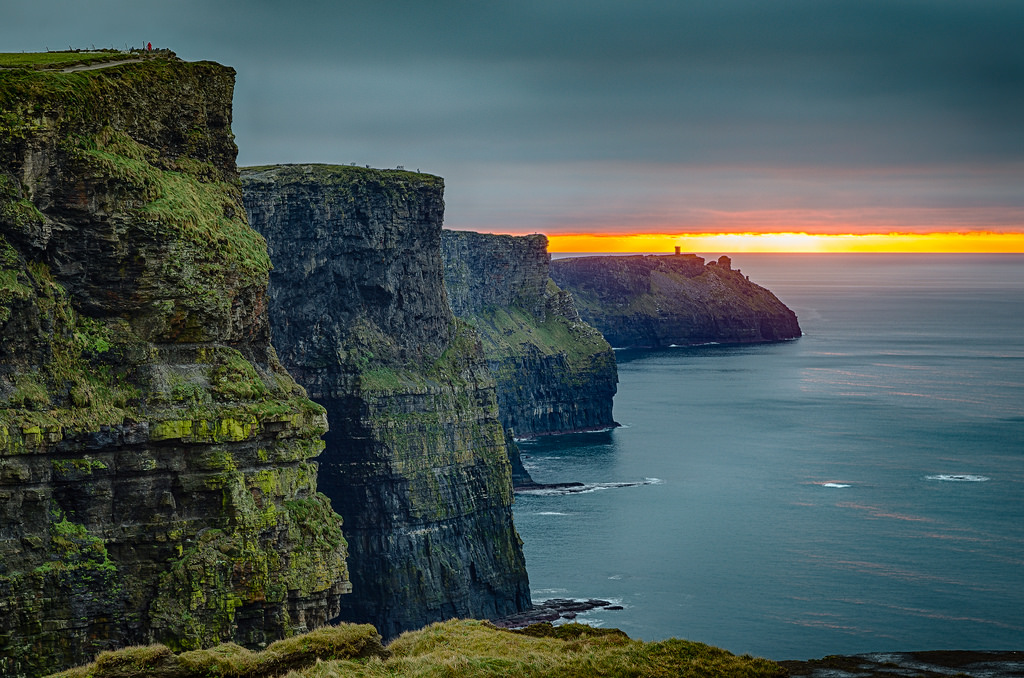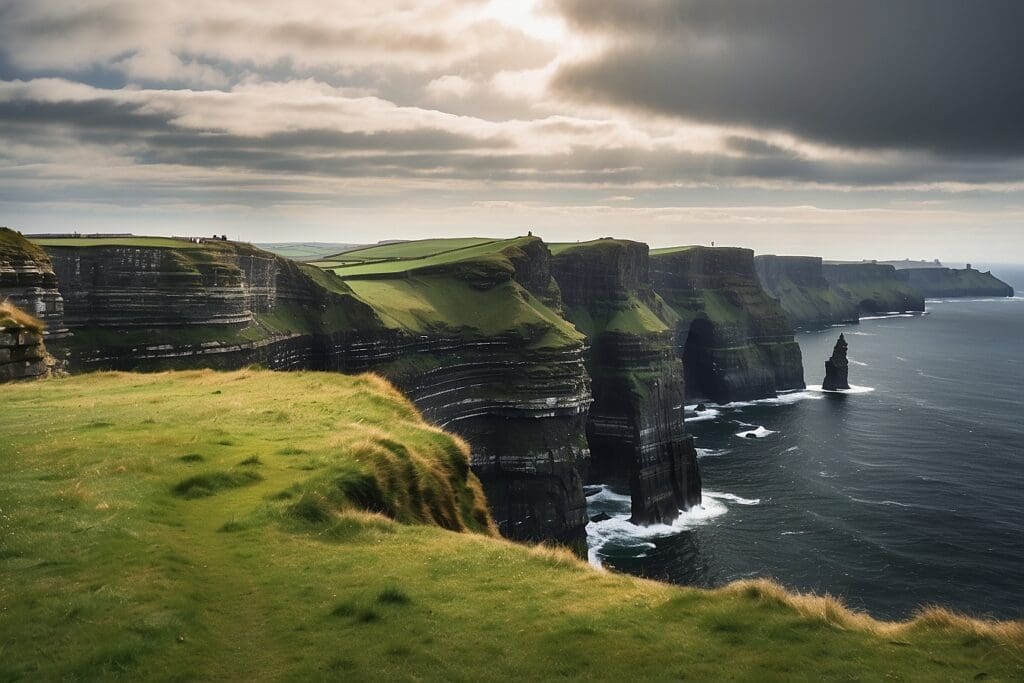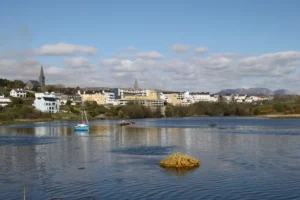360 Degree Video of The Cliffs of Moher, Ireland

Updated On: April 15, 2024 by Ciaran Connolly
Standing tall and proud along the rugged coastline of County Clare in Ireland, the Cliffs of Moher are a breathtaking natural marvel that never fails to captivate visitors from around the world. With their sheer size, dramatic vistas, and rich history, these cliffs have become an iconic symbol of Ireland’s wild beauty.
Stretching for about 14 kilometres along the Atlantic Ocean, the Cliffs of Moher rise to staggering heights of up to 214 meters, making them one of the most impressive coastal cliffs in Europe. In this article, we delve into the fascinating allure of the Cliffs of Moher, exploring their geological formation, ecological significance, cultural importance, and the experience they offer visitors.
Geological Formation Of The Cliffs Of Moher
The story of the Cliffs of Moher begins over 300 million years ago, during the Upper Carboniferous period. These majestic cliffs are primarily composed of sandstone, shale, and siltstone layers formed from sediment accumulation in a shallow sea. Over millions of years, the relentless forces of erosion sculpted the coastline, gradually revealing the magnificent cliffs we see today. The distinct horizontal layers in the cliffs provide a fascinating glimpse into the region’s geological history, with each layer representing a different era of deposition and environmental change.
One of the most striking features of the Cliffs of Moher is their verticality, which results from a combination of factors, including the uplift of the landmass, tectonic activity, and the erosive power of the Atlantic Ocean. The cliffs are constantly shaped by the pounding of waves, wind, and rain, leading to occasional rockfalls and landslides that contribute to their ever-changing landscape.
Ecological Significance
Beyond their aesthetic appeal, the Cliffs of Moher are also of great ecological significance, providing a vital habitat for a diverse array of seabirds, marine life, and plant species. The cliffs are home to one of Ireland’s largest mainland seabird colonies, with thousands of birds nesting on the narrow ledges and crevices carved into the rock face. Species such as puffins, razorbills, guillemots, and fulmars can be spotted wheeling and diving around the cliffs, adding to drama and spectacle.
The surrounding coastal waters are teeming with marine life, including seals, dolphins, and basking sharks, which thrive in the nutrient-rich waters of the Atlantic. The intertidal zone along the base of the cliffs supports a diverse community of seaweeds, mollusks, and crustaceans, which play a crucial role in the local ecosystem. Conservation efforts are underway to protect and preserve the delicate balance of this unique coastal environment, ensuring that future generations can continue to enjoy its natural beauty.
A Haven for Wildlife
Beyond their geological significance, the Cliffs of Moher are also a haven for diverse wildlife. The nutrient-rich waters of the Atlantic Ocean support a thriving ecosystem, attracting a variety of seabirds, including puffins, razorbills, guillemots, and fulmars. The cliffs provide vital nesting sites for these birds, who cling to the sheer rock faces with remarkable agility. Visitors to the cliffs can witness spectacular displays of aerial acrobatics as seabirds soar and swoop along the coastline, their cries mingling with the roar of the waves below.
In addition to seabirds, the waters surrounding the cliffs are also home to seals, dolphins, and even the occasional whale, adding to the area’s rich biodiversity. Conservation efforts are ongoing to protect these fragile ecosystems, ensuring that future generations can continue to marvel at the natural splendour of the Cliffs of Moher.
Cultural Importance
For centuries, the Cliffs of Moher have held a special place in the hearts and minds of the Irish people, inspiring poets, artists, and musicians with their grandeur and mystique. The cliffs feature prominently in Irish folklore and mythology, with tales of ancient warriors, mythical creatures, and tragic love stories echoing through the ages. The nearby village of Doolin, with its traditional music sessions and warm hospitality, serves as a gateway to the cliffs, welcoming visitors to experience the region’s rich cultural heritage.
In addition to their cultural significance, the Cliffs of Moher also hold historical importance, with evidence of human activity dating back thousands of years. Archaeological sites along the cliffs reveal traces of ancient settlements, burial mounds, and defensive structures, attesting to the enduring connection between people and the land. Today, the cliffs are a designated UNESCO Global Geopark and a protected natural area, ensuring their cultural and historical legacy is preserved for future generations to explore and appreciate.
Visitor Experience

Visiting the Cliffs of Moher is an unforgettable experience, allowing visitors to witness nature’s raw power and beauty in all its glory. A network of well-maintained walking trails will enable visitors to explore the cliffs at their own pace, with panoramic viewpoints offering awe-inspiring vistas of the Atlantic Ocean and the surrounding countryside. Guided tours and interpretive exhibits provide insight into the area’s geology, ecology, and history, enriching the visitor experience and fostering a deeper appreciation for this remarkable natural wonder.
For the more adventurous traveller, activities such as birdwatching, hiking, and sea kayaking offer unique ways to immerse oneself in the rugged beauty of the cliffs. Boat tours departing from nearby villages provide an alternative perspective, allowing visitors to admire the cliffs from the water and better understand their geological formation and ecological significance. Whether standing on the edge of the towering cliffs or gazing out to sea from the comfort of a boat, the experience of being in the presence of such natural grandeur will leave a lasting impression on all who visit.
Preserving a Natural Treasure
As one of Ireland’s most popular tourist attractions, the Cliffs of Moher face ongoing conservation and sustainable management challenges. Erosion, littering, and overcrowding are just some of the threats that must be addressed to ensure the long-term preservation of this natural treasure.
To mitigate these challenges, efforts are underway to implement sustainable tourism practices and promote responsible visitor behaviour. Conservation initiatives focus on habitat restoration, wildlife monitoring, and public education to balance preserving the natural environment and providing access for visitors to enjoy and appreciate its beauty.
Tourism and Conservation
The Cliffs of Moher have become a mecca for tourists, drawing over one million visitors annually. The site’s popularity has led to concerns about environmental impact and sustainability. Efforts have been made to manage visitor numbers, protect fragile ecosystems, and promote responsible tourism practices.
The Cliffs of Moher Visitor Experience, managed by the Cliffs of Moher Coastal Walk and Visitor Center, offers educational exhibits, guided tours, and interpretive trails, providing visitors with insights into the cliffs’ geological history, wildlife, and cultural significance. Visitors are encouraged to respect the natural environment, stay on designated paths, and avoid disturbing nesting birds.
Conservation initiatives aim to preserve and enhance the area’s biodiversity, safeguarding habitats for native flora and fauna. The Burren and Cliffs of Moher UNESCO Global Geopark work to promote sustainable tourism, community engagement, and conservation efforts within the region, ensuring that future generations can continue to enjoy and appreciate this natural wonder.
Exploring Attractions Near the Cliffs of Moher
The Cliffs of Moher, with their stunning natural beauty and rich cultural heritage, are undoubtedly the highlight of any County Clare, Ireland visit. However, the surrounding area offers many attractions and activities for visitors to enjoy, from charming villages and historical sites to outdoor adventures and scenic landscapes. Here are some notable attractions near the Cliffs of Moher that complement a visit to this iconic natural landmark:
1. The Burren
Just a short drive north of the Cliffs of Moher lies the Burren, a unique karst landscape renowned for its otherworldly beauty and rich biodiversity. This vast expanse of limestone pavement is dotted with ancient ruins, megalithic tombs, and rare flora, making it a paradise for hikers, botanists, and history enthusiasts alike. Visitors can explore the Burren’s intricate network of walking trails, marvel at its fascinating geological formations, and discover hidden gems such as Poulnabrone Dolmen, an ancient portal tomb dating back over 5,000 years.
2. Doolin
The picturesque village of Doolin, located just a few kilometres north of the Cliffs of Moher, is famous for its vibrant traditional music scene, warm hospitality, and stunning coastal scenery. Visitors can stroll along the village’s quaint streets, browse local craft shops, and sample delicious seafood at one of its charming restaurants or pubs. Doolin also serves as a gateway to the Aran Islands, with regular ferry services departing from nearby Doolin Pier to Inisheer, Inishmaan, and Inishmore, allowing visitors to explore these rugged and remote islands steeped in Gaelic culture and history.
3. The Aran Islands
A short boat ride from the mainland, the Aran Islands offer a unique glimpse into traditional Irish life and culture. These ruggedly beautiful islands are home to ancient stone forts, Christian monastic sites, and quaint fishing villages, where time seems to stand still. Visitors can explore the island’s scenic trails, cycle along winding coastal roads, and experience the warmth and hospitality of the local community. Highlights include Dun Aonghasa, a spectacular cliff-top fort on Inishmore, and the quaint village of Kilronan on Inishmore, with its colourful houses and bustling harbour.
4. Loop Head Peninsula
To the south of the Cliffs of Moher lies the Loop Head Peninsula, a hidden gem renowned for its dramatic cliffs, pristine beaches, and rich maritime heritage. Visitors can follow the scenic Loop Head Drive, winding along a rugged coastline and past historic lighthouses, picturesque villages, and ancient ruins. Highlights include Loop Head Lighthouse, offering panoramic views of the Atlantic Ocean and Shannon Estuary, and Kilkee, a charming seaside town with sandy beaches, rock pools, and scenic cliff walks.
5. Lahinch
Nestled along the Wild Atlantic Way, the seaside town of Lahinch is a paradise for outdoor enthusiasts, offering world-class surfing, championship golf courses, and scenic coastal walks. Visitors can hit the waves at Lahinch Beach, one of Ireland’s premier surfing destinations, or tee off at Lahinch Golf Club, ranked among the top links courses in the world. The town also boasts a vibrant arts and music scene, with live performances, art galleries, and cultural events throughout the year.
Conclusion
The Cliffs of Moher stand as a testament to the raw power of nature and the enduring beauty of Ireland’s coastline. From their towering heights to the tumultuous seas below, they captivate the imagination and inspire wonder in all who behold them. Whether you come for the breathtaking views, the rich biodiversity, or the cultural heritage, a visit to the Cliffs of Moher is an experience not to be missed.






